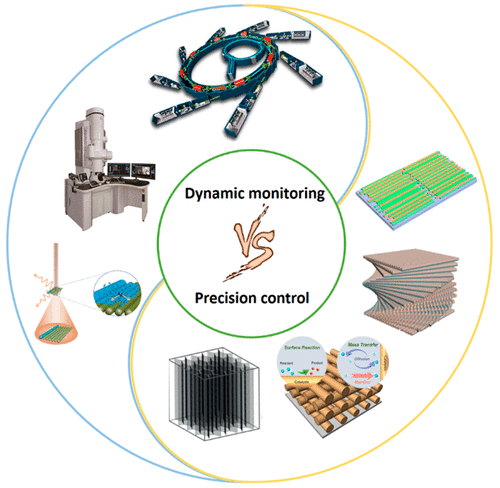当前位置:
X-MOL 学术
›
Acc. Chem. Res.
›
论文详情
Our official English website, www.x-mol.net, welcomes your feedback! (Note: you will need to create a separate account there.)
Self-Assembly of Nanowires: From Dynamic Monitoring to Precision Control
Accounts of Chemical Research ( IF 18.3 ) Pub Date : 2022-05-17 , DOI: 10.1021/acs.accounts.2c00052 Zhen He 1, 2 , Jin-Long Wang 1, 2 , Si-Ming Chen 2 , Jian-Wei Liu 2 , Shu-Hong Yu 1, 2
Accounts of Chemical Research ( IF 18.3 ) Pub Date : 2022-05-17 , DOI: 10.1021/acs.accounts.2c00052 Zhen He 1, 2 , Jin-Long Wang 1, 2 , Si-Ming Chen 2 , Jian-Wei Liu 2 , Shu-Hong Yu 1, 2
Affiliation

|
Natural biomaterials often show ordered nanowire structures (ONWS) which display unique structural color or superior mechanical performance. Meanwhile, plenty of modern nanodevices with ONWS have flourished with activities focused on both basic and applied research. Manipulating synthetic nanowire (NW) from a disordered state to a hierarchically ordered structure via various assembly strategies brings about intriguing and exotic chemical/physical properties. In the past decades, many methods have been developed to assemble NWs and fabricate organized architectures, such as Langmuir–Blodgett interfacial assembly, spin-coating assembly, fluid-flow-induced assembly, and ice-template assembly. Nevertheless, for practical applications, large-scale and high-efficiency assembly strategies toward precise controlled architectures are largely limited by the lack understanding of assembly mechanisms. Especially, the manipulation principles and driving forces behind the state-of-art assembly strategies are still unclear. Besides, the lesser research attention on dynamic kinetics also impedes the revelation of the NW self-assembly mechanism. With the emergence of advanced in situ techniques, such as synchrotron-based X-ray techniques and in situ transmission electron microscopy (TEM), the dynamic monitoring of NW behavior in many practical environments becomes possible. In addition, the alignment direction and the stacking manner of NW film are of significance to the final performance. There is a lack of connection between the properties of one-dimensional nanoscale building blocks and the functionalities of the macro-assembly structures. To this end, dynamic monitoring is highly desired, which enables the precision modulation of NW assembly structure, leading to the discovery or prediction of new structures, novel properties, and performance optimization.
中文翻译:

纳米线的自组装:从动态监测到精密控制
天然生物材料通常显示出有序的纳米线结构 (ONWS),其显示出独特的结构颜色或卓越的机械性能。与此同时,大量具有 ONWS 的现代纳米器件蓬勃发展,活动集中于基础研究和应用研究。通过各种组装策略将合成纳米线 (NW) 从无序状态转变为层次有序的结构会带来有趣和奇异的化学/物理特性。在过去的几十年中,已经开发了许多方法来组装 NW 和制造有组织的结构,例如 Langmuir-Blodgett 界面组装、旋涂组装、流体流动诱导组装和冰模板组装。然而,对于实际应用,针对精确受控架构的大规模和高效组装策略在很大程度上受到对组装机制缺乏了解的限制。特别是,最先进的装配策略背后的操纵原理和驱动力仍不清楚。此外,对动态动力学的研究关注较少也阻碍了NW自组装机制的揭示。随着先进的原位技术的出现,例如基于同步加速器的 X 射线技术和原位透射电子显微镜 (TEM),在许多实际环境中动态监测 NW 行为成为可能。此外,NW薄膜的排列方向和堆叠方式对最终性能也很重要。一维纳米级构件的性质与宏观组装结构的功能之间缺乏联系。为此,非常需要动态监测,这使得能够对 NW 组装结构进行精确调制,从而发现或预测新结构、新特性和性能优化。
更新日期:2022-05-17
中文翻译:

纳米线的自组装:从动态监测到精密控制
天然生物材料通常显示出有序的纳米线结构 (ONWS),其显示出独特的结构颜色或卓越的机械性能。与此同时,大量具有 ONWS 的现代纳米器件蓬勃发展,活动集中于基础研究和应用研究。通过各种组装策略将合成纳米线 (NW) 从无序状态转变为层次有序的结构会带来有趣和奇异的化学/物理特性。在过去的几十年中,已经开发了许多方法来组装 NW 和制造有组织的结构,例如 Langmuir-Blodgett 界面组装、旋涂组装、流体流动诱导组装和冰模板组装。然而,对于实际应用,针对精确受控架构的大规模和高效组装策略在很大程度上受到对组装机制缺乏了解的限制。特别是,最先进的装配策略背后的操纵原理和驱动力仍不清楚。此外,对动态动力学的研究关注较少也阻碍了NW自组装机制的揭示。随着先进的原位技术的出现,例如基于同步加速器的 X 射线技术和原位透射电子显微镜 (TEM),在许多实际环境中动态监测 NW 行为成为可能。此外,NW薄膜的排列方向和堆叠方式对最终性能也很重要。一维纳米级构件的性质与宏观组装结构的功能之间缺乏联系。为此,非常需要动态监测,这使得能够对 NW 组装结构进行精确调制,从而发现或预测新结构、新特性和性能优化。



























 京公网安备 11010802027423号
京公网安备 11010802027423号